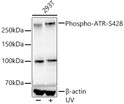| Tissue Specificity | Ubiquitous, with highest expression in testis. Isoform 2: Isoform 2 is found in pancreas, placenta and liver but not in heart, testis and ovary. |
| Post Translational Modifications | Phosphorylated. Autophosphorylation at Thr-1989 in response to DNA damage promotes interaction with TOPBP1 and activation of ATR. |
| Function | Serine/threonine protein kinase which activates checkpoint signaling upon genotoxic stresses such as ionizing radiation (IR), ultraviolet light (UV), or DNA replication stalling, thereby acting as a DNA damage sensor. Recognizes the substrate consensus sequence ST-Q. Phosphorylates BRCA1, CHEK1, MCM2, RAD17, RBBP8, RPA2, SMC1 and p53/TP53, which collectively inhibit DNA replication and mitosis and promote DNA repair, recombination and apoptosis. Phosphorylates 'Ser-139' of histone variant H2AX at sites of DNA damage, thereby regulating DNA damage response mechanism. Required for FANCD2 ubiquitination. Critical for maintenance of fragile site stability and efficient regulation of centrosome duplication. Acts as a regulator of the S-G2 transition by restricting the activity of CDK1 during S-phase to prevent premature entry into G2. Acts as a regulator of the nuclear envelope integrity in response to DNA damage and stress. Acts as a mechanical stress sensor at the nuclear envelope: relocalizes to the nuclear envelope in response to mechanical stress and mediates a checkpoint via phosphorylation of CHEK1. Also promotes nuclear envelope rupture in response to DNA damage by mediating phosphorylation of LMNA at 'Ser-282', leading to lamin disassembly. Involved in the inflammatory response to genome instability and double-stranded DNA breaks: acts by localizing to micronuclei arising from genome instability and catalyzing phosphorylation of LMNA at 'Ser-395', priming LMNA for subsequent phosphorylation by CDK1 and micronuclei envelope rupture. The rupture of micronuclear envelope triggers the cGAS-STING pathway thereby activating the type I interferon response and innate immunity. Positively regulates the restart of stalled replication forks following activation by the KHDC3L-OOEP scaffold complex. |
| Protein Name | Serine/Threonine-Protein Kinase AtrAtaxia Telangiectasia And Rad3-Related ProteinFrap-Related Protein 1 |
| Database Links | Reactome: R-HSA-1221632Reactome: R-HSA-176187Reactome: R-HSA-3371453Reactome: R-HSA-5685938Reactome: R-HSA-5693607Reactome: R-HSA-5693616Reactome: R-HSA-6783310Reactome: R-HSA-6796648Reactome: R-HSA-6804756Reactome: R-HSA-69473Reactome: R-HSA-9709570 |
| Cellular Localisation | NucleusChromosomeNucleus EnvelopeDepending On The Cell TypeIt Can Also Be Found In Pml Nuclear BodiesRecruited To Chromatin During S-PhaseRedistributes To Discrete Nuclear Foci Upon Dna DamageHypoxia Or Replication Fork StallingRelocalizes To The Nuclear Envelope In Response To Mechanical Stress Or Dna DamageAlso Localizes To The Micronuclear Envelope In Response To Response To Genome Instability |
| Alternative Antibody Names | Anti-Serine/Threonine-Protein Kinase Atr antibodyAnti-Ataxia Telangiectasia And Rad3-Related Protein antibodyAnti-Frap-Related Protein 1 antibodyAnti-ATR antibodyAnti-FRP1 antibody |
Information sourced from Uniprot.org









